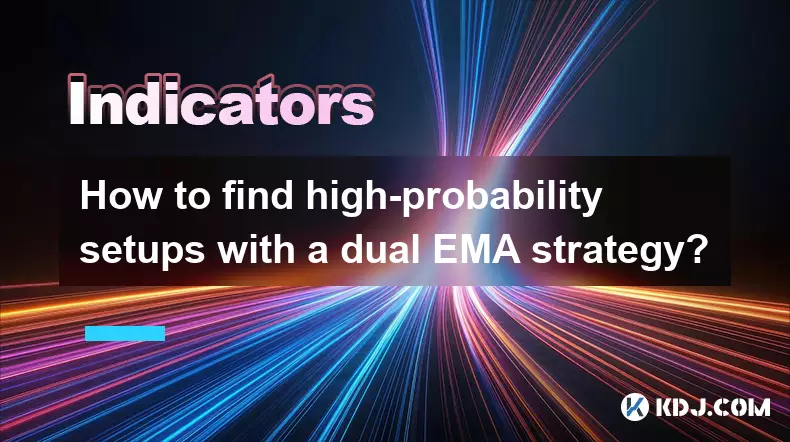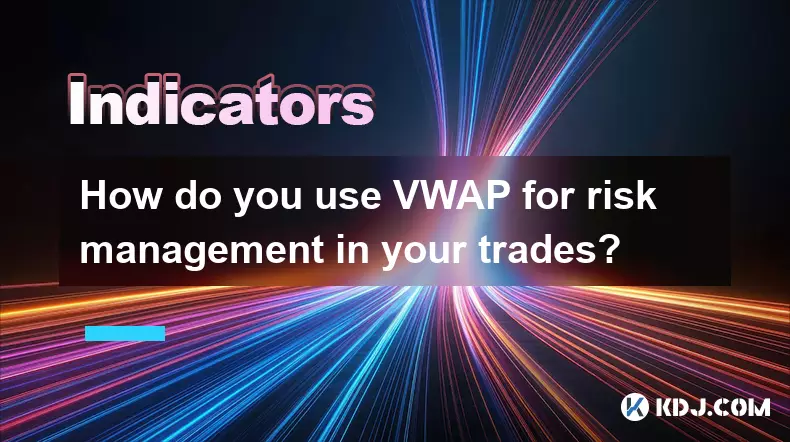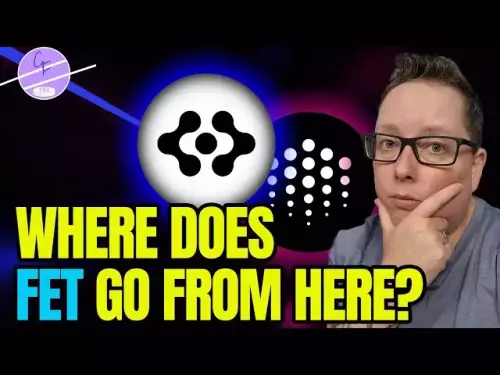-
 bitcoin
bitcoin $114684.631706 USD
-0.87% -
 ethereum
ethereum $4228.677447 USD
1.58% -
 bnb
bnb $1294.880693 USD
-1.16% -
 tether
tether $1.000819 USD
-0.02% -
 xrp
xrp $2.605138 USD
2.79% -
 solana
solana $209.908690 USD
5.89% -
 usd-coin
usd-coin $0.999903 USD
-0.03% -
 dogecoin
dogecoin $0.213423 USD
2.93% -
 tron
tron $0.322721 USD
-0.10% -
 cardano
cardano $0.727247 USD
3.66% -
 hyperliquid
hyperliquid $42.339456 USD
6.05% -
 chainlink
chainlink $19.910811 USD
5.16% -
 ethena-usde
ethena-usde $1.000557 USD
0.00% -
 stellar
stellar $0.349734 USD
2.69% -
 bitcoin-cash
bitcoin-cash $543.848687 USD
-0.21%
How to find high-probability setups with a dual EMA strategy?
The dual EMA strategy uses short- and long-term exponential moving averages to identify crypto trends, with crossovers signaling potential entries—best confirmed by volume, support/resistance, and RSI for higher accuracy.
Oct 12, 2025 at 01:19 am

Understanding the Dual EMA Framework in Crypto Trading
1. The dual EMA strategy relies on two exponential moving averages—one short-term and one long-term—to identify trend direction and potential entry points within the volatile cryptocurrency markets. Traders typically use combinations such as the 9-day and 21-day EMAs, though variations exist based on trading style and asset volatility.
2. When the shorter EMA crosses above the longer EMA, it generates a bullish signal, often referred to as a 'golden cross.' Conversely, when the shorter EMA drops below the longer one, it forms a 'death cross,' indicating bearish momentum. These crossovers serve as foundational triggers for trade setups.
3. Unlike simple moving averages, EMAs place greater weight on recent price data, making them more responsive to sudden shifts common in digital asset prices. This responsiveness increases the likelihood of catching early moves but also raises the risk of false signals during choppy or sideways market conditions.
4. To improve accuracy, traders should apply the dual EMA strategy on multiple timeframes. For instance, aligning a daily chart crossover with confirmation from the 4-hour chart can filter out noise and increase confidence in the setup.
5. It is essential to recognize that EMAs are lagging indicators. They reflect past price behavior rather than predict future movements. Relying solely on EMA crossovers without additional confluence factors may lead to suboptimal results, especially during periods of low volume or consolidation.
Confluence Factors That Increase Setup Probability
1. Volume spikes accompanying an EMA crossover add credibility to the signal. In the crypto space, surges in trading volume often precede strong directional moves, particularly after breakouts from key support or resistance zones.
2. Aligning EMA signals with horizontal price levels enhances reliability. A golden cross occurring near a well-established support level in Bitcoin or Ethereum increases the probability of a successful long position.
3. Incorporating candlestick patterns improves timing. For example, a bullish engulfing pattern forming at the same time as a crossover provides stronger evidence of buyer conviction.
4. Using oscillators like the Relative Strength Index (RSI) helps avoid overbought or oversold traps. Entering a long trade when the RSI is already above 70, even if the EMAs have crossed upward, may result in limited upside and increased drawdown risk.
5. Monitoring on-chain metrics adds another layer of validation. Increasing exchange outflows or rising active addresses coinciding with a bullish EMA crossover suggest underlying demand is building, supporting the technical signal.
Practical Application Across Major Cryptocurrencies
1. In Bitcoin’s weekly chart, dual EMA crossovers have historically marked major trend reversals. The 2019 golden cross preceded a rally from $3,800 to nearly $20,000, demonstrating the power of this strategy in capturing macro moves.
2. Altcoins like Solana and Avalanche exhibit exaggerated trends, making EMA strategies particularly effective when combined with momentum filters. Rapid price accelerations following crossovers are common due to lower liquidity and higher speculative interest.
3. Stablecoins and low-volatility tokens generally produce poor results with this method. The lack of sustained trends leads to frequent whipsaws, where EMAs cross back and forth without meaningful price follow-through.
4. During bull markets, shorter EMA combinations (e.g., 5 and 13) adapt faster to accelerating prices. In bear markets, longer settings (e.g., 50 and 100) help avoid premature entries during downtrend rallies.
5. Backtesting across different market cycles reveals that dual EMA strategies perform best in trending environments. Range-bound phases, such as those seen in late 2022 across most large-cap cryptos, generate excessive false signals and erode capital through repeated losing trades.
Frequently Asked Questions
What are the best EMA periods for day trading cryptocurrencies?The 8 and 21 EMA combination is widely used among crypto day traders. This pairing balances sensitivity and reliability, particularly on 15-minute and 1-hour charts. Shorter intervals like 5 and 13 may work in high-momentum situations but require tighter risk controls.
Can the dual EMA strategy be automated?Yes, many algorithmic trading bots support EMA crossover logic. Platforms like 3Commas or Gunbot allow users to define EMA parameters, set stop-loss and take-profit levels, and execute trades automatically when conditions are met. However, constant monitoring is necessary to adjust for changing volatility.
How do you reduce false signals in sideways markets?Adding a trend filter such as the Average Directional Index (ADX) helps. When ADX is below 25, it indicates a ranging market, and traders can choose to ignore EMA crossovers until directional strength returns. Another approach is requiring price to close beyond a recent swing point before acting on the signal.
Is the dual EMA strategy suitable for all crypto assets?No, it works best on liquid, high-market-cap coins with clear trends. Low-cap altcoins prone to pump-and-dump schemes often generate misleading crossovers due to manipulative trading activity. Stick to established assets like BTC, ETH, BNB, or ADA for more consistent outcomes.
Disclaimer:info@kdj.com
The information provided is not trading advice. kdj.com does not assume any responsibility for any investments made based on the information provided in this article. Cryptocurrencies are highly volatile and it is highly recommended that you invest with caution after thorough research!
If you believe that the content used on this website infringes your copyright, please contact us immediately (info@kdj.com) and we will delete it promptly.
- XRP Price Prediction: Weekend Rollercoaster or Rally?
- 2025-10-12 08:45:16
- Bittensor (TAO): Super Bullish Signals Point to Potential 2x Rally
- 2025-10-11 10:25:12
- Silver Price Correction: Navigating the Dip & Identifying Key SEO Keywords
- 2025-10-11 10:25:12
- Decoding Crypto Trends: Bittensor's Bull Run, Cardano's Dip, and LivLive's Presale Buzz in 'Uptober 2025'
- 2025-10-12 08:45:16
- MoonBull: The Crypto Meme Coin Promising 1000x Gains?
- 2025-10-11 10:30:01
- Crypto Payroll Revolution: Stablecoins, Altcoins, and the Future of Salary Payments
- 2025-10-11 10:30:01
Related knowledge

What's the main difference between VWAP and TWAP?
Oct 12,2025 at 11:54am
Understanding VWAP and Its Role in Crypto Trading1. Volume Weighted Average Price (VWAP) is a trading benchmark that calculates the average price of a...

How do you identify exhaustion moves using VWAP and its bands?
Oct 12,2025 at 08:00am
Understanding the Role of Decentralized Exchanges in Crypto Trading1. Decentralized exchanges (DEXs) operate without a central authority, allowing use...

How do you use VWAP to scale in and out of positions?
Oct 14,2025 at 02:19am
Understanding VWAP as a Dynamic Benchmark1. The Volume Weighted Average Price (VWAP) is not just an indicator—it functions as a dynamic benchmark that...

What are the main advantages of using VWAP over EMA?
Oct 11,2025 at 02:18am
Main Advantages of Using VWAP Over EMA1. Volume-Weighted Average Price (VWAP) incorporates trading volume into its calculation, offering a more accura...

How do you use VWAP on different chart types like Heikin Ashi?
Oct 11,2025 at 05:01pm
Understanding VWAP in the Context of Heikin Ashi Charts1. The Volume Weighted Average Price (VWAP) is a powerful analytical tool commonly used by trad...

How do you use VWAP for risk management in your trades?
Oct 11,2025 at 02:54am
Understanding VWAP as a Dynamic Benchmark1. The Volume Weighted Average Price (VWAP) serves as a crucial reference point in intraday trading by reflec...

What's the main difference between VWAP and TWAP?
Oct 12,2025 at 11:54am
Understanding VWAP and Its Role in Crypto Trading1. Volume Weighted Average Price (VWAP) is a trading benchmark that calculates the average price of a...

How do you identify exhaustion moves using VWAP and its bands?
Oct 12,2025 at 08:00am
Understanding the Role of Decentralized Exchanges in Crypto Trading1. Decentralized exchanges (DEXs) operate without a central authority, allowing use...

How do you use VWAP to scale in and out of positions?
Oct 14,2025 at 02:19am
Understanding VWAP as a Dynamic Benchmark1. The Volume Weighted Average Price (VWAP) is not just an indicator—it functions as a dynamic benchmark that...

What are the main advantages of using VWAP over EMA?
Oct 11,2025 at 02:18am
Main Advantages of Using VWAP Over EMA1. Volume-Weighted Average Price (VWAP) incorporates trading volume into its calculation, offering a more accura...

How do you use VWAP on different chart types like Heikin Ashi?
Oct 11,2025 at 05:01pm
Understanding VWAP in the Context of Heikin Ashi Charts1. The Volume Weighted Average Price (VWAP) is a powerful analytical tool commonly used by trad...

How do you use VWAP for risk management in your trades?
Oct 11,2025 at 02:54am
Understanding VWAP as a Dynamic Benchmark1. The Volume Weighted Average Price (VWAP) serves as a crucial reference point in intraday trading by reflec...
See all articles










































































